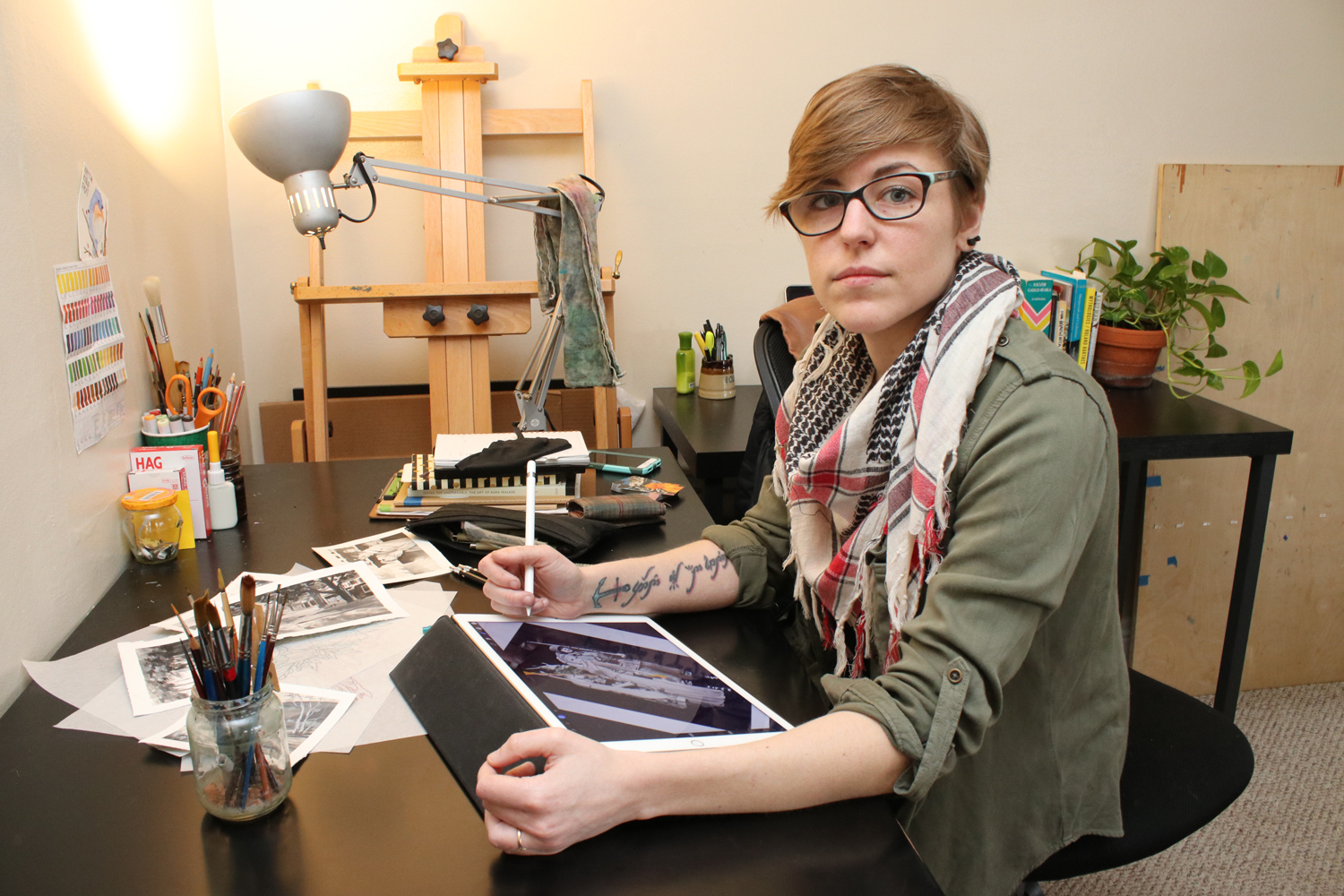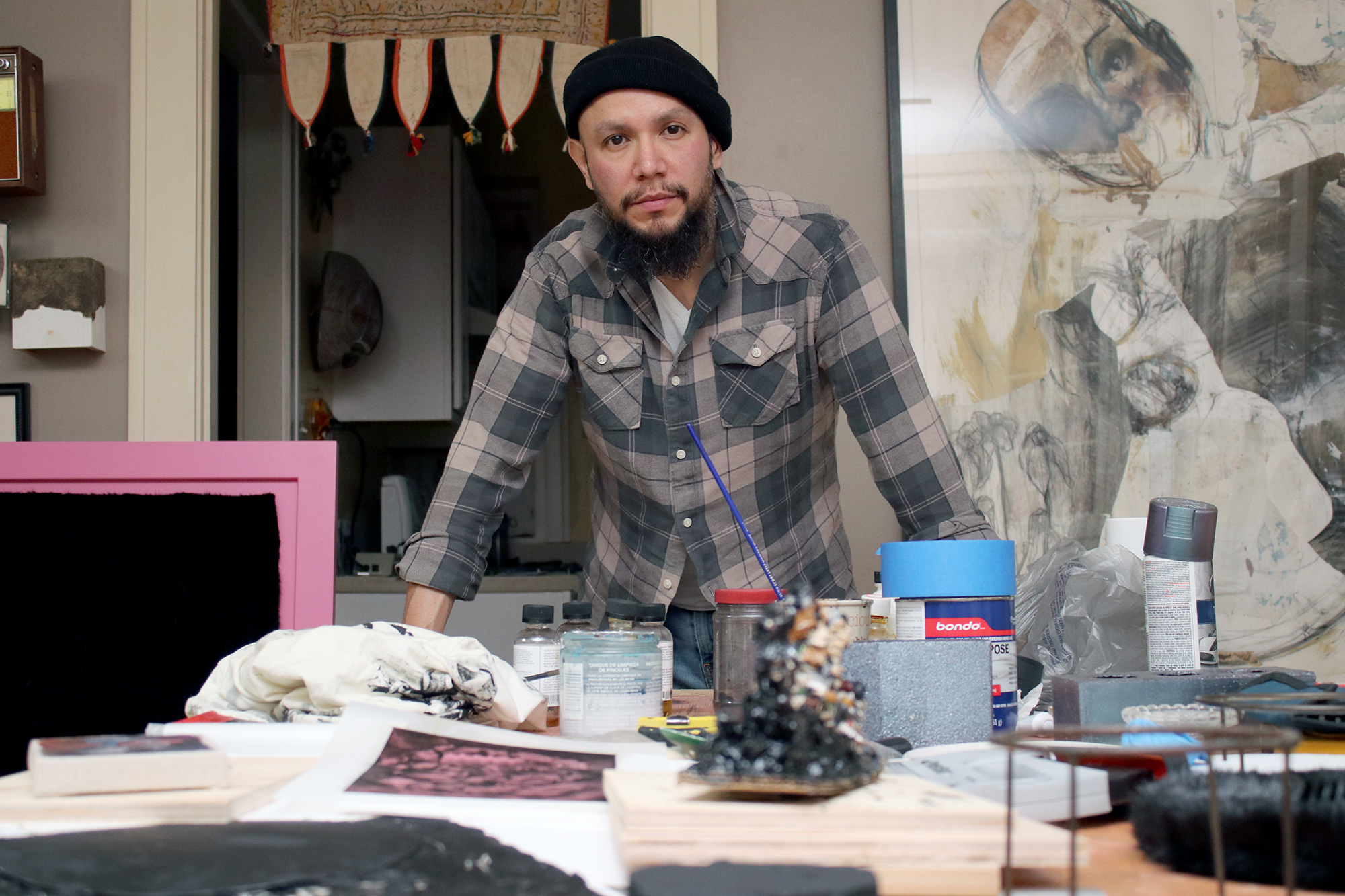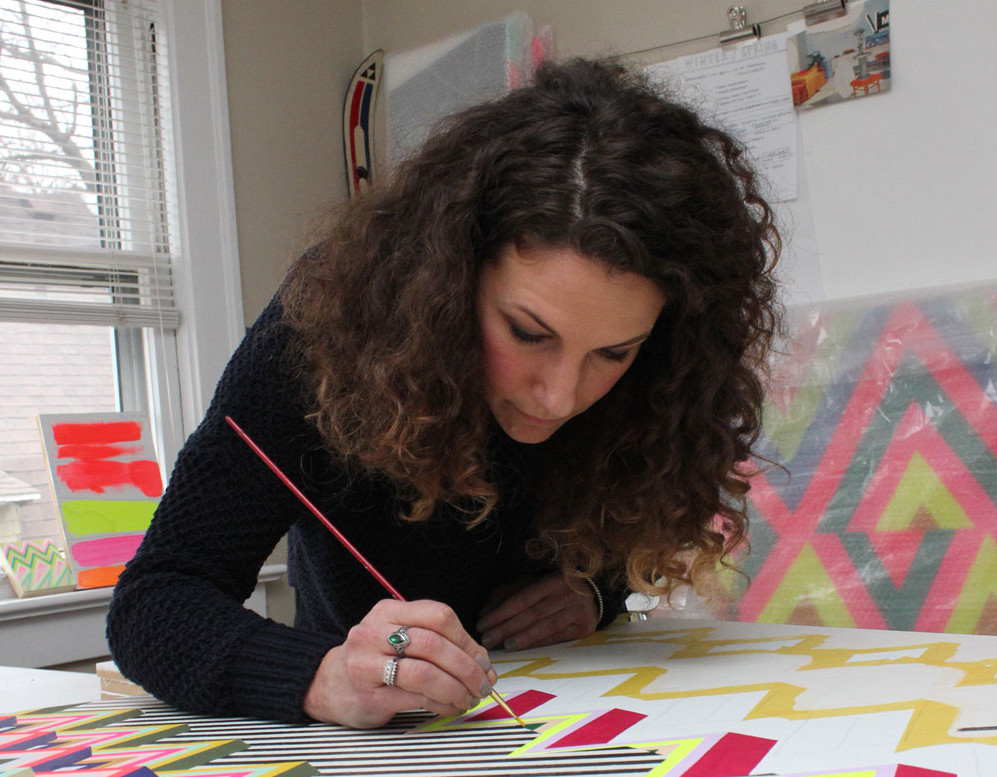How Timothy Callaghan sees his neighborhood
Story by Carlo Wolff
Moving into a new neighborhood requires openness and curiosity. Walk the neighborhood to familiarize yourself with its contours, its complexion, its conveniences and inconveniences. Learn what makes your neighborhood tick, street by street, maybe even resident by resident. Another way to do that is to drive or cycle around the area. Take the time – if you can.
Eventually – at least in Timothy Callaghan’s case – this learning, born of many forms and spells of looking and interacting and thinking, generates two kinds of art: smaller, walnut ink drawings and larger, polychromatic gouaches. As Callaghan’s two-pronged art shares subject matter, the drawings and paintings reflect, even comment, on each other. Both iterations make the viewer feel at home.
Welcome to Callaghan’s neighborhood.

Callaghan’s work is all about place. It is quotidian, strenuously specific and hyperlocal. It’s also vivid and strangely affecting, whether it’s a sun-dappled Glenville backyard or a broadly marked, vintage car in a North Collinwood driveway. Warm, yet neutral, it never succumbs to picture-postcard sentimentality.
In mid-October, Callaghan was tying up a virtual residency at The Madison, a building on East 105th Street in Cleveland’s Glenville neighborhood that served as one of several unofficial homes to FRONT International, the Northeast Ohio art celebration former advertising magnate Fred Bidwell launched this past summer. While he wasn’t a designated FRONT artist, on Bidwell’s invitation Callaghan wound up occupying a studio overlooking 105th Street. There, he developed 15 to 20 pieces reflecting on his temporary neighborhood, a collection he hopes to exhibit at some point.
“With these paintings, the process combines three types of observation,” including direct observation and “really working from the source. I do take a photograph with my cell phone as a reference for when I get back into the studio,” Callaghan elaborates. “The third type of observation is just working from memory. You get to a certain point where you’re not looking at the study or a reference, you’re just looking at the painting and remembering colors. But I also don’t feel obligated to get the color exactly right.”
Callaghan is bent on streamlining his process and on expanding outside Northeast Ohio, his focus so far. His modus operandi, he says, involves “leaving the building, going out, drawing in walnut ink for a while” to make a tighter study, “then scaling that up to a larger gouache.”
“They’re certainly not en plein air paintings,” he says, referencing a technique pioneered by 20th century French landscape painters. “I like beginning on location because there are things that happen that you just don’t anticipate, and I like drawing or painting from other senses like smells and sounds,” he says. Such openness “leads the process somewhere else.”

Stretching out
Born in Toledo in 1976, Callaghan grew up in Temperance, Mich., a “very rural” Toledo suburb. At the Toledo Museum of Art, a portrait of the poet Frank O’Hara burned itself into his brain. He moved to Cleveland in 1994, earning a Bachelor of Fine Arts degree from the Cleveland Institute of Art in 1999 and an MFA from Kent State University in 2005. Callaghan, his wife – artist, seamstress and garment designer Krista Tomorowitz –
and their young son, Hayes, have lived in North Collinwood since 2012. For the past four years, Callaghan has taught at Lake Ridge Academy, a private preparatory school in North Ridgeville, and in 2013, he published “One Painting a Day,” a book as much about work ethic as about art.
Callaghan is “completely obsessed with 20th century American painters” like Edward Hopper and Alex Katz, and as a kid, he loved seeing Fairfield Porter’s portrait of Frank O’Hara lying on a flowery yellow couch. “I don’t know what it was about that painting,” he says, “but looking at it more in college, it just sort of struck me that (he was) being so, so specific. Something about his work was specific about a place and time, specific about light and color.” Porter, like Callaghan, painted “everyday life.”
The tension that makes Callaghan’s art so compelling involves the relationship between inspiration and artistic creation. How deeply do you have to bond with a place to represent it faithfully, let alone honor it? His art, which celebrates and honors place in making it the story – the figure in the narrative, as it were – may always be dynamic and coiled and forward, which is not a criticism but a hope.
Telling the story of place
Where Callaghan is eager to explore new terrain, he has come to know North Collinwood especially well and likes being a part of it.
North Collinwood, which in effect “chose” him as an artistic subject, became its own body of work. In May, Callaghan exhibited a selection of his North Collinwood paintings at a Maria Neil Art Project pop-up show in the renovated La Salle Theatre on East 185th Street, the neighborhood’s main thoroughfare.
“It was really emotional for me to see people from the neighborhood come out – probably because they wanted to see the building – but they also had a look at my paintings for a little bit, and I had some great conversations that weekend,” he says, noting they also wanted “to share stories with me” about that neighborhood. “You ultimately want a painting to get someone excited to share a story.”
By contrast, he worked in his Glenville studio only from April to mid-October and suggests his Glenville art is “more of a tourist snapshot because I’m not as familiar with the streets; you have to spend a long time to know a place.”
“How long does it take to observe, to look at something, to really see it?” is his question. What and how much you see changes over time and accumulates with familiarity, he suggests.
Still, he’s always interested in interaction, in how he affects a space and vice versa, and he wants to finish this Glenville project, show the results, and maybe take “the show on the road.” As Callaghan winds up in Glenville, he’s still struggling to gauge the amount of time required to experience a neighborhood in order to turn it into art that feels authentic. This struggle is likely to go on, fueling his creations. Callaghan doesn’t want to be a drive-by artist. Depth is his goal.

Putting his distinctive stamp on a place is what sets Callaghan apart, suggests Cleveland arts eminence William Busta, who showcased Callaghan in the 2006 debut exhibition of his William Busta Gallery on Prospect Avenue in Cleveland.
Callaghan’s “spare style, in which objects appeared to float in dimensional space,” appeals to Busta, as does his paradoxical talent for “making the intimate and public both monumental and ordinary.”
If the relative austerity of Callaghan’s drawings memorialize a place, his paintings are, perhaps, more joyous. “I think there is an intention to try to elevate the subject matter, in a way, and I think most of it comes from color,” he says. “I don’t think there’s a typical palette that you’d see that could be called Midwestern,” he adds. “The colors are sort of intensified,” in service to the goal of creating “something that would make the viewer pause.”
“Part of his achievement is that he neither romanticizes nor offers the bite of social commentary,” Busta says. “His work says ‘This is us.’ He edits to the essential and uses colors that somehow comfort.
“So, the work is about the artist and the city and us.”

Honing his skills
It’s also about technique, Callaghan says. “I’m thinking about ways to make the paintings as efficient as possible … (and) within that, I’ve been thinking about what is the right size for the right area, the scale of it, while keeping it away from being, like, really loose and quick.” He wants “the viewer to see the process, be able to see the raw surface, so that things just kind of show a linear narrative of where the painting starts and ends.”
One reason he left oil on canvas for gouache and acrylic paintings on paper is “I like the idea of the paper with one stroke being the sort of pressure point … the paper can only take so much abuse, so you can’t just scrape it out and keep painting. There’s this pressure to get it right and that creates an opportunity for something new to happen – or you just rip up the paper and start again.”
Working in paper exclusively also means his “mark making” – his strokes often seem analogous to pixels in how they coalesce into what looks solid – had to become more deliberate. “They’re still representational paintings,” he says of his work, “and I’m doing things that are about illusion, especially with light, but there is no illusion to the fact that they are just one mark, one shot, maybe two. Otherwise, you start to destroy the paper.”
The drawings, meanwhile, require lots of planning to determine how the light should play. “You can always get something darker but you can’t get it lighter.”
The medium of paper – or, more accurately, its limitations – imposes a kind of discipline, he suggests, and “made me think about the process much differently.” His acrylic-based gouaches have a “flatness and a veneer” that present “a different luminosity.”
Whether drawing or painting, Callaghan wants to tell a story, even as his own story evolves, even as he’s restless to experience places other than Ohio.
“A painting becomes a narrative,” he says. “I made a conscious effort a long time ago to take the figure out of these spaces and focus more on space because I realized that was what I was really interested in: the space. What is that relationship between space and place? It’s like the viewer is part of the connection, part of the conversation, the story that takes it from space to being this kind of meaningful place.” CV

On view
Timothy Callaghan has works in two shows that opened in November: “Recent Acquisitions,” Nov. 16 to Feb. 15, 2019, at ARTneo, 1305 W. 80th St., #016, Cleveland, and “Continuum: The Cleveland School and Beyond,” Nov. 21 to March 3, 2019, at the Canton Museum of Art, 1001 Market Ave. N, Canton.
Lead Image: As Timothy Callaghan discusses his artwork, walnut ink drawings of Cleveland’s Glenville neighborhood hang on the wall of the Glenville studio he occupied during FRONT International. Photo by Michael C. Butz.











